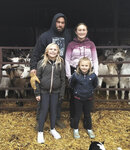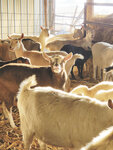

ALBANY, Minn. — The sound of goats bleating while they roam his farm south of Albany is something that Tyler Gerads has heard for more than a year.
Milking is not a foreign concept to Gerads; however, milking goats is.
On the dairy, where Gerads farms about 150 acres and milks cows, he added over 160 milking goats to his work load, with plans to expand his goat herd. His herd is a mix of Alpines, Saanens, Lamanchas and a few Nubian mixes.
Along with the other chores found around the farm, Gerads also does custom hoof trimming. To make everything work, Gerads relies on the help of his three children: Kendra, Aleena and Kianna.
“The milking is just me in the morning,” Gerads said. “The girls help with the evening milking. When it comes to the kidding, everyone helps.”
While most goat farmers would have dried up their goats over winter, Gerads did not. He freshens goats year-round and balances that with his hoof-trimming business, spreading the workload throughout the entire year. However, it does lead to a challenge for him.
“It’s hard because all the goats I bought were always bred in the fall,” Gerads said. “I need to get the gestation period on track for an all-year breeding season.”
To help the goats adjust to the new breeding schedule, Gerads had LED lights installed in the bedding pack area where the goats are housed. Gerads said this helps make the goats cycle more regularly so that they can be bred year-round.
“That helps me in winter so that I don’t have them all kidding at one time,” Gerads said.
Having kids throughout the year helps Gerads manage his time so he was able to add goats to his operation.
“(Milking goats) was something I was always interested in doing,” Gerads said. “Then, I just took the step and started the construction, such as knocking out walls, building the pit and pouring cement. I built the parlor and milk room myself.”
The road to begin milking goats was complicated. Gerads toured farms and did research before purchasing the goats. It took him a year, from concept to reality, to bring the goats to the farm.
Along the way, Gerads had help from his farm consulting team, including his nutritionist Kate McAndrews, Minnesota Goat Milk LLC field representative Missy Isder and goat farmer Brad Donnay.
The mentors helped Gerads make decisions and showed Gerads ways to keep his goats healthy. He figured out the differences between caring for goats versus cows. He also learned how to manage kidding.
Every day at 3:45 a.m., Gerads heads to the barn to get everything rinsed and set up for the goats. While Gerads is milking, the goats are also fed grain. Once the milking is done, the lines are washed and rinsed, and everything gets cleaned again. The goats are milked again at 3:45 p.m.
Gerads also milks cows twice each day at 5:30 a.m. and 5:30 p.m. Each of the four milkings takes about an hour.
Just like cows, Gerads knows goats can also suffer from mastitis and milk fever. He learned that the practices for identifying ailments and offering treatment is the same in both species, so the care is something he was already familiar with.
Gerads said having his idea come to fruition has been positive.
“The highlight for me was that I lucked out and ended up with a good herd of goats,” Gerads said. “For not knowing a thing about goats when I went to go look at them, I still managed to start with nice, healthy animals.”
Comments
No comments on this item Please log in to comment by clicking here